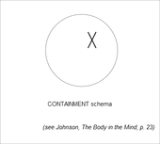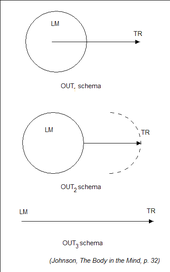
Image schema
Encyclopedia

Cognition
In science, cognition refers to mental processes. These processes include attention, remembering, producing and understanding language, solving problems, and making decisions. Cognition is studied in various disciplines such as psychology, philosophy, linguistics, and computer science...
processes which establishes patterns of understanding and reasoning. Image schemas are formed from our bodily interactions, from linguistic experience, and from historical context. The term is explained in Mark Johnson
Mark Johnson (professor)
Mark L. Johnson is Knight Professor of Liberal Arts and Sciences in the Department of Philosophy at the University of Oregon. He is well-known for contributions to embodied philosophy, cognitive science and cognitive linguistics, some of which he has coauthored with George Lakoff such as...
's book The Body in the Mind, in case study 2 of George Lakoff
George Lakoff
George P. Lakoff is an American cognitive linguist and professor of linguistics at the University of California, Berkeley, where he has taught since 1972...
's Women, Fire and Dangerous Things and by Rudolf Arnheim in Visual Thinking.
In contemporary cognitive linguistics
Cognitive linguistics
In linguistics, cognitive linguistics refers to the branch of linguistics that interprets language in terms of the concepts, sometimes universal, sometimes specific to a particular tongue, which underlie its forms...
, an image schema is considered an embodied prelinguistic structure of experience that motivates conceptual metaphor
Conceptual metaphor
In cognitive linguistics, conceptual metaphor, or cognitive metaphor, refers to the understanding of one idea, or conceptual domain, in terms of another, for example, understanding quantity in terms of directionality . A conceptual domain can be any coherent organization of human experience...
mappings. Evidence for image schemata is drawn from a number of related disciplines, including work on cross-modal cognition in psychology
Psychology
Psychology is the study of the mind and behavior. Its immediate goal is to understand individuals and groups by both establishing general principles and researching specific cases. For many, the ultimate goal of psychology is to benefit society...
, from spatial cognition in both linguistics
Linguistics
Linguistics is the scientific study of human language. Linguistics can be broadly broken into three categories or subfields of study: language form, language meaning, and language in context....
and psychology, and from neuroscience
Neuroscience
Neuroscience is the scientific study of the nervous system. Traditionally, neuroscience has been seen as a branch of biology. However, it is currently an interdisciplinary science that collaborates with other fields such as chemistry, computer science, engineering, linguistics, mathematics,...
.
Johnson: From image schemas to abstract reasoning via metaphor

Image schemas are dynamic embodied patterns—they take place in and through time. Moreover, they are multi-modal patterns of experience, not simply visual. For instance, consider how the dynamic nature of the containment schema is reflected in the various spatial senses of the English word out. Out may be used in cases where a clearly defined trajector (TR) leaves a spatially bounded landmark (LM), as in: John went out of the room. Mary got out of the car. Spot jumped out of the pen.
In the most prototypical of such cases the landmark is a clearly defined container. However, out may also be used to indicate those cases where the trajector is a mass that spreads out, effectively expanding the area of the containing landmark: She poured out the beans. Roll out the carpet. Send out the troops.
Finally, out is also often used to describe motion along a linear path where the containing landmark is implied and not defined at all: The train started out for Chicago.
Experientially basic and primarily spatial image schemas such as the Containment schema and its derivatives the Out schemas lend their logic to non-spatial situations. For example, one may metaphorically use the term out to describe non-spatial experiences: Leave out that big log when you stack the firewood. (Schema used directly and non-metaphorically.) I don't want to leave any relevant data out of my argument. (Schema metaphorically projected onto argumentation.) Tell me your story again, and don't leave out any details. (Schema metaphorically projected onto story-telling.) She finally came out of her depression. (Schema metaphorically projected onto emotional life.)
Johnson argues that more abstract reasoning is shaped by such underlying spatial patterns. For example, he notes that the logic of containment is not just a matter of being in or out of the container. For example, if someone is in a deep depression, we know it is likely to be a long time before they are well. The deeper the trajector is in the container, the longer it will take for the trajector to get out of it. Similarly, Johnson argues that transitivity and the law of the excluded middle in logic are underlaid by preconceptual embodied experiences of the Containment schema.
Lakoff: Image schemas in Brugman's The story of Over
In case study two of his book Women, Fire and Dangerous Things, Lakoff re-presented the analysis done of the English word over done by Claudia Brugman in her doctoral dissertation. Similar to the analysis of out given by Johnson, Lakoff argued that there were six basic spatial schemas for the English word over. Moreover, Lakoff gave a detailed accounting of how these schemas were interrelated in terms of what he called a radial category structure. For example, these six schemas could be both further specified by other spatial schemas such as whether the trajector was in contact with the landmark or not (as in the plane flew over the mountain vs. he climbed over the mountain). Furthermore Lakoff identified a group of "transformational" image schemata such as rotational schemas and path to object mass, as in Spider-Man climbed all over the wall. This analysis raised profound questions about how image schemas could be grouped, transformed, and how sequences of image schemas could be chained together in language, mind and brain.Relationships to similar theories
Johnson indicates that his analysis of out drew upon a doctoral dissertation by Susan Lindner in linguistics at Berkeley, and more generally by the theory of cognitive grammar put forth by Ronald LangackerRonald Langacker
Ronald Wayne Langacker is an American linguist and professor emeritus at the University of California, San Diego. He is best known as one of the founders of the cognitive linguistics movement and the creator of Cognitive Grammar....
(Langacker 1987). For the force group of image schemas Johnson also drew on an early version of the force dynamic
Force Dynamics
Force dynamics is a semantic category that describes the way in which entities interact with reference to force. Force Dynamics gained a good deal of attention in cognitive linguistics due to its claims of psychological plausibility and the elegance with which it generalizes ideas not usually...
schemas put forth by Len Talmy, as used by linguists such as Eve Sweetser. Other influences include Wertheimer's gestalt structure theory and Kant's account of schemas
Schema (Kant)
In Kantian philosophy, a schema is the procedural rule by which a category or pure, non-empirical concept is associated with a mental image of an object...
in categorization, as well as studies in experimental psychology on the mental rotation
Mental rotation
Mental rotation is the ability to rotate mental representations of two-dimensional and three-dimensional objects.-Introduction:Mental rotation is somewhat localized to the right cerebral hemisphere. It is thought to take place largely in the same areas as perception...
of images.
In addition to the dissertation on over by Brugman, Lakoff's use of image schema theory also drew extensively on Talmy and Langacker's theories of spatial relations terms as well.
Lists of image schemas
While Johnson provided an initial list of image schemas in The Body in the Mind (p. 126), his diagrams for them are scattered throughout his book and he only diagrammed a portion of those image schemas he listed. In his work, Lakoff also used several additional schemas.Johnson 1987:
- Spatial motion group
- Containment
- Path
- Source-Path-Goal
- Blockage
- Center-Periphery
- Cycle
- Cyclic Climax
- Force Group
- Compulsion
- Counterforce
- Diversion
- Removal of Restraint
- Enablement
- Attraction
- Link
- Scale
- Balance Group
- Axis Balance
- Point Balance
- Twin-Pan Balance
- Equilibrium
- Listed but unsketched and undiscussed in Johnson
- Contact
- Surface
- Full-Empty
- Merging
- Matching
- Near-Far
- Mass-Count
- Iteration
- Object
- Splitting
- Part-Whole
- Superimposition
- Process
- Collection
Additional schemas discussed in Lakoff 1987:
- Spatial group
- Above
- Across
- Covering
- Contact
- Vertical Orientation
- Length (extended trajector)
- Transformational group
- Linear path from moving object (one dimensional trajector)
- Path to endpoint (endpoint focus)
- Path to object mass (path covering)
- Multiplex to mass (possibly the same as Johnson's undefined Mass-Count)
- Reflexive (both part-whole and temporally different reflexives)
- Rotation
Image schemas proposed and discussed by others:
-
- Rough-smooth/Bumpy-smooth (Rohrer; Johnson and Rohrer)
See also
- Schema (psychology)Schema (psychology)A schema , in psychology and cognitive science, describes any of several concepts including:* An organized pattern of thought or behavior.* A structured cluster of pre-conceived ideas....
- Force DynamicsForce DynamicsForce dynamics is a semantic category that describes the way in which entities interact with reference to force. Force Dynamics gained a good deal of attention in cognitive linguistics due to its claims of psychological plausibility and the elegance with which it generalizes ideas not usually...
- Cognitive linguisticsCognitive linguisticsIn linguistics, cognitive linguistics refers to the branch of linguistics that interprets language in terms of the concepts, sometimes universal, sometimes specific to a particular tongue, which underlie its forms...
- Conceptual metaphorConceptual metaphorIn cognitive linguistics, conceptual metaphor, or cognitive metaphor, refers to the understanding of one idea, or conceptual domain, in terms of another, for example, understanding quantity in terms of directionality . A conceptual domain can be any coherent organization of human experience...
- Embodied philosophy
- Schema (Kant)Schema (Kant)In Kantian philosophy, a schema is the procedural rule by which a category or pure, non-empirical concept is associated with a mental image of an object...
- Mark JohnsonMark Johnson (professor)Mark L. Johnson is Knight Professor of Liberal Arts and Sciences in the Department of Philosophy at the University of Oregon. He is well-known for contributions to embodied philosophy, cognitive science and cognitive linguistics, some of which he has coauthored with George Lakoff such as...

